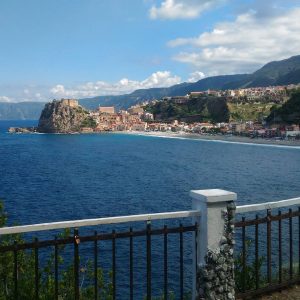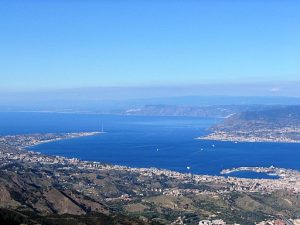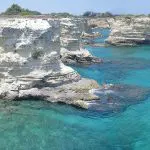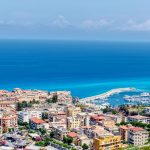Chianalea in Scilla is one of the most beautiful fishing villages in the province of Reggio Calabria. Built directly on the seafront, its narrow streets and pastel-colored houses are charming, but as the sun sets, the village’s lights reflect in the nearby water making it utterly enchanting.

This small fishing village is known for its traditional swordfish hunting traditions. When visiting Scilla from May to September, you’ll most likely see the unique fishing boats that are used to hunt this local delicacy.
Scilla sits on one side of the Strait of Messina, which is said to be the mythological village where the six-headed sea monster, Scylla, threatened Ulysses in The Odyssey.
According to Homer, Ulysses had to navigate the narrow channel (believed to be the Strait of Messina) between Scylla and Charybdis.
Scylla and Charybdis were two mythical sea monsters who lived in the Strait of Messina.

Charybdis, the daughter of Poseidon and Gaia (Mother Earth), was known for her voracious character. Ancient myths tell the story of Hercules, who was passing the Strait of Messina on a ship and Charybdis who ravaged the ship eating his flock of oxen. Hercules went to Zeus asking for justice, so Zeus turned Charybdis into a monster. She was to remain on the shores opposite Scylla where she would gulp the sea waters and then forcefully send it back three times stronger causing whirlpools that either swallowed ships or caused violent shipwrecks.
Scylla, on the other hand, was said to be a nymph of incredible beauty, who spent her days playing on the shores of the Strait, rejecting any suitors that presented themselves to her. One of these suitors was Glaucus, a Greek sea god who was born mortal but became immortal after eating a magical herb. Glaucus became hopelessly in love with Scylla and turned to Circe, a goddess of magic for help. Instead of a love potion, Circe cursed the waters that Scylla played in, which transformed her into a horrible monster with twelve tentacle-like legs, six heads each with huge jaws and three rows of sharp teeth. Embarrassed by her appearance, she hid beneath the sea and unleashed her anger on any passing sailors.

So, you can see Ulysses’ dilemma. Convinced that passing close to Charybdis would certainly result in the loss of both ship and crew, he chose the lesser of the two evils and passed along the cliffs of Scylla’s lair, where six of his men were devoured by Scylla.
This is only one of many versions of the story that you’ll hear told. One thing is certain – Scilla will capture you with her mesmerizing beauty.
We are visiting Scilla as part of our September Small Heritage Tour. We’d love for you to join us! You can find out more about the tour here!









